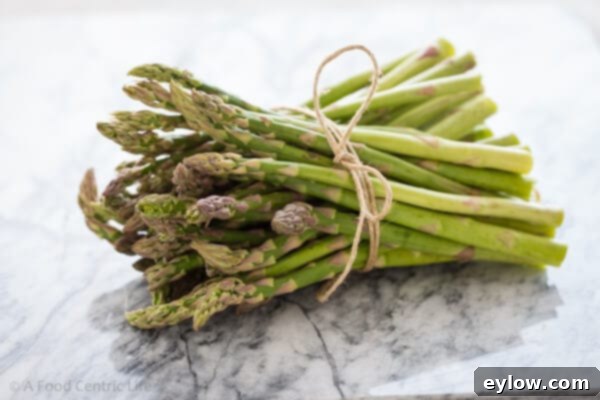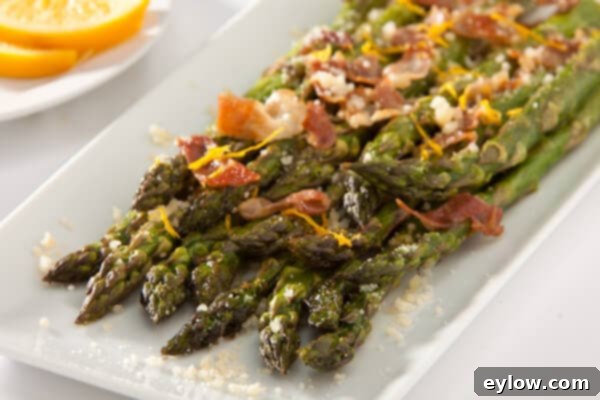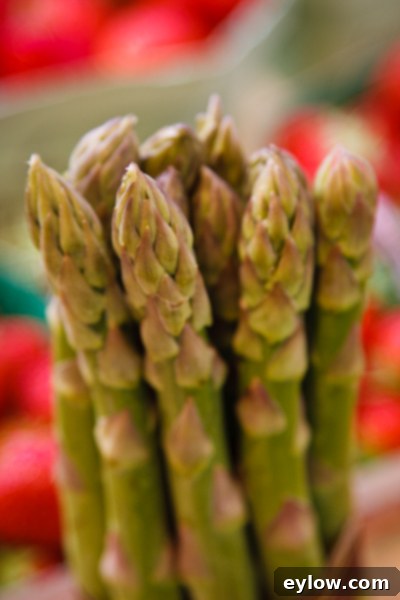Effortlessly Delicious: The Ultimate Guide to Perfectly Roasted Asparagus
Roast asparagus is a quintessential springtime side dish, celebrated for its vibrant flavor, tender-crisp texture, and incredible ease of preparation. This simple cooking method transforms fresh asparagus spears into a delightful accompaniment for almost any meal, requiring minimal effort and just a few minutes in a hot oven. My preferred technique involves roasting in a high-temperature oven until the asparagus is perfectly crisp-tender – never soggy! Whether you enjoy it simply seasoned with olive oil, salt, and pepper, or elevate it with a gourmet garnish or a zesty homemade vinaigrette, roasted asparagus is a versatile and healthy addition to your culinary repertoire.

Asparagus is a nutritional powerhouse and a wonderfully versatile vegetable that I could happily enjoy daily. Its adaptability allows for numerous culinary explorations beyond just roasting. You can steam it for a light crunch, add it to a vibrant stir-fry, or even purée it into a beautiful and creamy asparagus soup. Each preparation method brings out a unique aspect of its flavor and texture, but for sheer simplicity and deliciousness, roasting often takes the crown. The dry heat of the oven brings out its natural sweetness and provides a lovely slight caramelization, resulting in a side dish that’s both healthy and incredibly satisfying.
Why You’ll Love This Easy Roasted Asparagus Recipe
Roasting asparagus isn’t just a method; it’s a revelation. Here’s why this simple dish deserves a permanent spot in your weekly meal rotation:
- Effortlessly Simple: This recipe requires minimal ingredients and even less fuss. With just a few basic pantry staples, you can transform fresh asparagus into an elegant side dish in under 15 minutes. It’s perfect for busy weeknights or when you need a quick yet impressive addition to a special meal.
- Incredibly Versatile: Roasted asparagus pairs beautifully with almost any main course, from grilled chicken and pan-seared fish to succulent steaks and hearty vegetarian dishes. Its mild, earthy flavor profile complements a wide range of cuisines. Moreover, it can be easily customized with various seasonings and garnishes to match your meal’s theme.
- Naturally Delicious & Healthy: Roasting enhances the natural sweetness of asparagus, bringing out its best flavor without masking it. Asparagus is also packed with essential vitamins (A, C, K), folate, and antioxidants, making it a fantastic low-calorie, nutrient-dense choice for a healthy diet.
- Quick Cleanup: By lining your baking sheet with foil or parchment paper, you can minimize cleanup, making this not only a quick dish to cook but also a breeze to tidy up afterwards.
Essential Ingredients for Perfect Roasted Asparagus
You only need a handful of ingredients to create this delicious side dish, focusing on fresh, high-quality asparagus.
- Asparagus: The star of our show! When selecting asparagus, look for bright green spears with tightly closed, firm tips. Avoid any spears that appear yellowed, withered, or have soft, open tips, as these are signs of age. Ideally, your grocery store will keep asparagus standing in a little cold water to maintain its freshness and prevent drying out. I generally prefer medium-sized spears because they offer a satisfying “meaty” texture without being overly tough or woody. Super-thin spears cook much faster and can become flimsy, while very fat spears take a bit longer to become tender. Adjust cooking times accordingly based on the thickness you choose.
- Oil: Extra virgin olive oil is my top choice, as it imparts a lovely, fruity flavor that complements asparagus beautifully. However, you can also use light olive oil, avocado oil, or grapeseed oil, especially if you plan to roast at a very high temperature or prefer a more neutral flavor.
- Seasoning: A simple sprinkle of salt and freshly ground black pepper is often all you need. The natural flavor of the asparagus truly shines with minimal seasoning.
For precise measurements, please refer to the detailed recipe card below.
Exciting Substitutions and Flavor Variations
While classic roasted asparagus is delicious on its own, it also serves as a fantastic canvas for various flavor profiles. Don’t hesitate to experiment with these ideas to keep things interesting:
- For a delightful Asian-inspired flavor, swap out the olive oil for toasted sesame oil. After roasting, a sprinkle of toasted sesame seeds and a dash of soy sauce or tamari can elevate the dish with nutty and umami notes.
- Instead of just salt and pepper, get creative with a spice blend. Popular choices include “Everything But The Bagel” seasoning (Trader Joe’s version is a favorite!), lemon pepper, garlic powder, onion powder, or a vibrant Italian seasoning blend.
- Create endless variations using simple garnishes added after roasting. Consider a sprinkle of fresh herbs like chopped parsley, chives, or dill. Crispy, chopped bacon or prosciutto adds a savory crunch. A finely chopped hard-boiled egg offers a rich texture, while grated Parmesan cheese melts slightly on the warm spears for a cheesy finish. Don’t forget the brightness of fresh zested lemon peel, which can lift all the flavors.
- Another wonderful option is to drizzle the hot asparagus with a light vinaigrette. A classic choice is an easy homemade Italian dressing, or for something different, a creamy ginger vinaigrette can add a unique zing. A simple balsamic glaze or a lemon-herb butter also works wonders.
Step-by-Step Roasted Asparagus Instructions
Preparing Your Asparagus for Roasting
Proper preparation is key to perfectly roasted asparagus. First, give your asparagus a quick rinse under cold water to remove any dirt. Crucially, pat it thoroughly dry with a clean kitchen towel or paper towels. Moisture on the spears will steam them rather than roast them, preventing that desirable crisp-tender texture and slight caramelization.
To prep the asparagus, you’ll need to remove the tough, woody ends. A common and effective method is to hold the bottom of a stalk and gently bend it near the end. It should naturally snap off at the point where the tender part meets the tough, fibrous base. This usually takes just a minute to do for an entire bunch. If you’re preparing a large quantity, you can snap off the ends of a few spears to get a feel for where they consistently break, then line up the remaining spears and efficiently cut off the ends with a sharp knife at that approximate point. This saves time without sacrificing quality.
Setting Up for Success: Get Ready to Roast
Before you begin, pre-heat your oven. For conventional oven mode, set the temperature to a hot 425°F (220°C). If you’re using a convection oven, 400°F (200°C) is often sufficient, as convection ovens cook more efficiently and evenly. While the oven heats, line a large, rimmed baking sheet with aluminum foil or parchment paper. This step is not just for easier cleanup, but also helps prevent sticking and promotes even browning.
Once prepped, arrange the asparagus spears in a single layer on the lined baking sheet. Ensure they have enough space and are not overcrowded; overcrowding can lead to steaming instead of roasting. Drizzle the spears evenly with your chosen oil, then sprinkle generously with salt and freshly ground black pepper. Sometimes, I also like to add a pinch of granulated garlic powder for an extra layer of savory flavor. Toss the asparagus gently with your hands to ensure each spear is lightly coated with oil and seasoning.
The Art of Roasting Asparagus to Perfection
Now for the main event! Place the baking sheet with the seasoned asparagus into your preheated oven. Roast for approximately 8-10 minutes. The exact timing will depend on several factors: the calibration of your oven, the desired level of tenderness you prefer, and most significantly, the thickness of your asparagus spears. Thinner spears will cook faster, sometimes in as little as 5-7 minutes, while very thick spears might require closer to 12-15 minutes.
To check for doneness, simply pierce a spear with the tip of a paring knife. It should be crisp-tender, meaning it offers a slight resistance but is easily pierced. You’re looking for spears that are vibrant green, with tips that might be slightly browned and crispy, indicating that delicious caramelization has occurred. Avoid overcooking, as this can result in soggy, limp asparagus, losing its desirable texture and fresh flavor.

Tips for Storing Asparagus to Keep it Fresh
Proper storage is crucial for maintaining the freshness and quality of asparagus. There are two primary methods to store asparagus, depending on how quickly you plan to use it:
- Standing Method (for a few days’ freshness): When you bring asparagus home from the grocery store, trim a small amount (about half an inch) off the bottom ends. Then, stand the asparagus spears upright in a glass jar or a tall container with about an inch of cold water in the bottom, ensuring the trimmed ends are submerged. Loosely cover the tips with a plastic bag (a produce bag works well) to create a humid environment, then refrigerate. Stored this way, asparagus can remain fresh and crisp for up to 3-5 days, much like a bouquet of flowers.
- Flat Method (for short-term use): For shorter storage or if you don’t have a tall container, you can trim the bottom ends of the asparagus. Wrap the trimmed ends in a damp paper towel, then place the entire bundle into a plastic zip-top bag. Seal the bag, leaving a small opening for air circulation, and store it in the refrigerator. This method is good for 2-3 days.
For longer storage, asparagus can be blanched briefly (2-4 minutes in boiling water, then immediately plunged into ice water) and then frozen. While frozen asparagus is excellent for soups, purées, or casseroles, it typically doesn’t hold its crisp texture well enough for direct roasting after thawing.

Elevate Your Roasted Asparagus: Creative Serving Ideas
Roasted asparagus is already fantastic on its own, but with a few simple additions, you can transform it into an even more impressive side dish. Here are some delightful ways to dress up your roast asparagus:
- Cheesy Delight: Sprinkle generously with freshly grated Parmesan cheese while still hot, allowing it to melt slightly. Other cheeses like crumbled feta, goat cheese, or even nutritional yeast can add a unique flavor twist.
- Crunch Factor: Scatter some toasted breadcrumbs (panko or regular, and easily made gluten-free) over the top for a wonderful crunchy texture contrast. For extra flavor, toast them with a little garlic powder and herbs.
- Savory & Meaty: Add chopped crisp bacon bits or thinly sliced, crisped prosciutto for a salty, savory kick. These rich additions pair exceptionally well with the subtle sweetness of asparagus.
- Nutty Notes: Use your favorite chopped nuts like walnuts, pine nuts, pecans, slivered almonds, or even macadamia nuts. For an extra layer of flavor, toasted pumpkin seeds (pepitas) or sunflower seeds are also excellent choices, providing a healthy crunch.
- Classic Sauces: Drizzle with a luxurious hollandaise sauce, a truly classic combination that elevates asparagus to an elegant dish, whether served warm or chilled. A simple lemon-butter sauce or a rich balsamic glaze can also add a gourmet touch.
- Herbal Freshness: For a burst of fresh flavor, try a dollop of homemade herbed mayonnaise or a vibrant pesto. A simple squeeze of fresh lemon juice and a sprinkle of fresh dill or chives are also refreshing.
Why Roasting is the Best Method for Asparagus
While asparagus can be boiled, steamed, or sautéed, roasting stands out as arguably the best method to cook this delicate vegetable. Here’s why:
- Enhanced Flavor: The dry heat of the oven promotes caramelization, a process that brings out and concentrates the natural sugars in the asparagus. This results in a deeper, sweeter, and slightly nutty flavor profile that steaming or boiling simply can’t achieve.
- Perfect Texture: Roasting delivers that ideal crisp-tender texture. The exterior gets a slight char and crispness, while the interior remains tender but not mushy. Boiling can lead to waterlogged, limp asparagus, and steaming, while better, often lacks the same depth of flavor and texture.
- Minimal Nutrient Loss: Unlike boiling, which can leach water-soluble vitamins (like Vitamin C and B vitamins) into the cooking water, roasting retains more of the asparagus’s beneficial nutrients.
- Ease and Convenience: As highlighted throughout this guide, roasting is incredibly simple. It’s a hands-off method that frees up your stovetop for other dishes, making it perfect for meal prepping or entertaining.
Tips for Perfectly Roasted Asparagus Every Time
Achieving consistently delicious roasted asparagus is easy with these simple tips:
- Choose Fresh Asparagus: The fresher the asparagus, the better the final result. Look for firm, bright green spears with closed tips.
- Wash and Dry Thoroughly: Always rinse your asparagus. Critically, pat it completely dry before adding oil and seasoning. Excess moisture will steam the asparagus instead of roasting it, preventing the desired browning and crispness.
- Trim Properly: Don’t skip trimming the woody ends. The snap test is generally reliable, ensuring you only cook the tender parts.
- Don’t Overcrowd the Pan: Arrange asparagus in a single layer on the baking sheet, leaving a little space between spears. If the pan is too crowded, the asparagus will steam in its own moisture rather than roast, leading to a softer texture. Use two baking sheets if necessary.
- High Heat is Key: Roasting at a high temperature (400-425°F or 200-220°C) is essential for achieving that desirable crisp exterior and tender interior quickly.
- Monitor Cooking Time: Asparagus cooks quickly. Start checking for doneness around 5-7 minutes for thinner spears and 8-10 minutes for medium spears. Overcooked asparagus becomes limp and loses its vibrant color.
- Season Generously: Don’t be shy with salt and pepper. They enhance the asparagus’s natural flavor. Consider adding garlic powder or lemon zest for extra zing.
Frequently Asked Questions About Roasting Asparagus
How do I choose the best asparagus at the grocery store?
Look for bright green spears with tightly closed, firm tips. The stalks should be firm and snap easily, not limp or rubbery. Avoid spears that look dull, dry, or have yellowed sections, as these indicate older asparagus.
What’s the ideal oven temperature for roasting asparagus?
A high temperature is best for roasting asparagus, typically between 400°F (200°C) and 425°F (220°C). This allows the asparagus to cook quickly, achieving a crisp-tender texture and a slight caramelization on the outside without becoming soggy.
How long does it take to roast asparagus?
Roasting time varies depending on the thickness of the spears and your oven. Thin spears might be ready in 5-7 minutes, while medium spears usually take 8-10 minutes. Thicker spears could require up to 12-15 minutes. Always check for crisp-tenderness with the tip of a knife.
Can I use frozen asparagus for this recipe?
While you can roast frozen asparagus, it generally doesn’t yield the same crisp-tender results as fresh. Frozen asparagus tends to release more water, leading to a softer, sometimes mushy texture. For best results, it’s highly recommended to use fresh asparagus when roasting.
How do I know when roasted asparagus is done?
Roasted asparagus is done when it’s bright green, slightly tender when pierced with a fork or knife, but still has a slight “snap” or resistance. The tips might be lightly browned and slightly crispy. Avoid cooking it until it’s completely limp and dull green.
Can I reheat roasted asparagus?
Yes, you can reheat roasted asparagus, but it’s best enjoyed fresh. To reheat, spread it on a baking sheet and warm it in a preheated oven (around 350°F / 175°C) for a few minutes until heated through. Microwaving is generally not recommended as it can make the asparagus soggy.

📖 Recipe

How to Roast Asparagus
Sally Cameron
Pin Recipe
Ingredients
- 1 bundle fresh asparagus tough ends trimmed
- 1 tablespoon olive oil
- Salt and pepper to taste
Optional Garnishes
- 6 slices Prosciutto sliced thin crosswise and crisped in a non-stick fry pan
- 3-4 tablespoons grated Parmesan cheese
- 2 tablespoons toasted breadcrumbs
- 2-3 tablespoons toasted chopped pecans or hazelnuts
- 1 tablespoon finely chopped fresh chives or parsley
- 1 tablespoon fresh lemon zest
Instructions
-
Pre-heat oven to 425 degrees F (220 C) or 400 degrees F (200 C) for convection. Line a rimmed baking sheet with foil or parchment paper for easy cleanup.
-
Place the trimmed asparagus spears in a single layer on the prepared baking sheet. Drizzle evenly with olive oil, then sprinkle with salt and pepper. Toss gently to ensure all spears are coated.
-
Roast for approximately 8-10 minutes, or until the asparagus is vibrant green and crisp-tender when pierced with the tip of a knife. Roasting time will vary based on spear thickness and oven calibration.
-
Remove from oven and serve immediately. Garnish with any optional toppings as preferred to enhance flavor and presentation.
